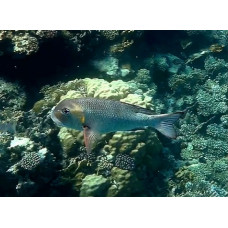Latin name
Monotaxis grandoculis
Other name
Humpnose big-eye bream, bigeye barenose, bigeye bream, bigeye emperor, grand-eyed porgy fish, humpnose sea-bream, large-eye bream, mu, roundtooth large-eye bream.
Identification
The humpnose big-eye bream has an elongated body with a depth of 2.1-2.7 times its standard length. The dorsal profile of the head forms a distinct hump in front of the eyes, below which is a steeply sloping snout. The eyes are large with a diameter approximately equal to the length of the snout. The rear edge of the tarsus is finely serrated. There are fanglike teeth in the anterior part of each jaw, which give way to fine teeth in the anterior part of the lateral parts of the jaws, and to molars in the posterior part of the jaws.
Features of fish fins
The dorsal fin has 10 spines and 10 soft rays, while the anal fin has 3 spines and 9 soft rays.
Fish colouring
The overall colouration of these fish is silver grey with thin dark edges on each scale and a large black spot in the pectoral groove. It usually has 3-4 black vertical stripes separated by thinner white stripes on the back. Juveniles have 3 broad dark brown to black saddle-like stripes on the body, the two posterior stripes ending in the dorsal fin. They have a black stripe across the eyes and a reddish stripe along the outside of the caudal fin blades.
Distribution
Widespread in the Indo-Pacific, from the Red Sea and the coast of East Africa to South Africa, across the Indian Ocean, although it is absent from the Persian Gulf. In the Pacific it extends east to Hawaii, north to southern Japan and south to Australia. In Australia, it is found on Christmas Island and the Cocos (Keeling) Islands, and from Ningaloo Reef, Rowley Bank and Scott Reef off Western Australia to north-northeast of Evans Bank in the Timor Sea, and from the northern Great Barrier Reef south to Seal Rocks in New South Wales, with juveniles reaching Sydney.
Habitat
A tropical marine benthopelagic species. Occurs near reefs in sandy and rubble areas at depths of 3 to 150 m (9.8 to 492.1 ft).
Size
The maximum published total length of this species is 60 cm, although 40 cm is more typical, and the maximum published weight is 5.9 kg.
Behavior
Found in sandy and rocky areas near coral reefs, often solitary but large adults can form schools of up to 50 individuals. Non-migratory.
Food and feeding habits
Nocturnal predator. Feeds on fish, gastropods, ophiuroids and echinoderms. Paguridae and Brachyurus crabs, polychaetes, crustaceans and holothurians are eaten in smaller quantities.
Reproduction
Female humpnose big-eye bream spawn in batches.
Fishing
They are targeted by commercial, artisanal and recreational fisheries. Methods used to catch these fish include the use of gill nets, fish traps, spear fishing and hooking.
Relationship with a person
The catch of this fish is sold fresh. In the Marshall Islands, eating this species is believed to cause ciguatera poisoning.
| Classification | |
| Phylum | Chordata |
| Class | Actinopterygii |
| Squad | Spariformes |
| Family | Lethrinidae |
| Genus | Monotaxis |
| Species | M. grandoculis |
| Features | |
| Conservation status | Least Concern |
| Habitat | Pelagic |
| Life span, years | No information |
| Maximum body weight, kg | 5,9 |
| Maximum length, cm | 60 |
| Sailing speed, m/s | No information |
| Threat to people | Edible |
| Way of eating | Predator |
Humpnose big-eye bream
Tags: humpnose big eye bream



